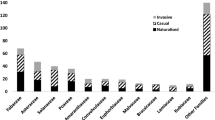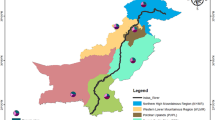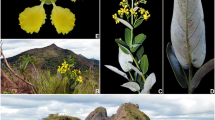Abstract
Invasive alien species are regarded as one of major drivers of global biodiversity loss, and correct taxonomic identification of these species at early stage of introduction is crucial in successful invasion management. Here we report Matricaria discoidea DC., an alien plant species, which has currently reached to the invasive stage in Kashmir Himalaya, India. The herbarium records revealed that although this alien species was first collected in the region about 4 decades before, it remained taxonomically misidentified, which impeded its timely management. To clarify the taxonomic identification and nomenclatural confusion of M. discoidea and validate its first distribution record in India, we provide a detailed taxonomic account, including description, delimiting characters with closely related species, photographic illustrations of diagnostic characters and distribution map. Our report will facilitate easier field identification of M. discoidea, thus inform policy and practice in invasion management and prevent its spread to the neighboring regions of Himalayan biodiversity hotspot.


(Photo credits: TI, AAK, GS)

(Photo credits: TI, AAK, GS)
Similar content being viewed by others
References
Abrams LR, Ferris RS (1960) Bignonias to sunflowers. In: Abrams LR (ed) Ill. Fl. Pacific States, vol 4. BJKJ Stanford University Press, Stanford, pp 399–586
Ahmad R, Khuroo AA, Hamid M, Malik AH, Rashid I (2019a) Scale and season determine the magnitude of invasion impacts on plant communities. Flora 260:151481
Ahmad R, Khuroo AA, Hamid M, Rashid I (2019b) Plant invasion alters the physico-chemical dynamics of soil system: insights from invasive Leucanthemum vulgare in the Indian Himalaya. Environ Monit Assess 191(3):1–15
Alexander JM, Edwards PJ, Poll M, Parks CG, Dietz H (2009) Establishment of parallel altitudinal clines in traits of native and introduced forbs. Ecology 90(3):612–622
Arshid S, Wani AA, Ganie AH, Khuroo AA (2016) On correct identification, range expansion and management implications of Myriophyllum aquaticum in Kashmir Himalaya, India. Check List 7(3):299–302
BHL (2020) Biodiversity Heritage Library. Available via https://www.biodiversitylibrary.org/page/31876281. Accessed 11 Nov 2020
Bremer K, Humphries CJ (1993) Generic monograph of the Asteraceae-Anthemideae. Bull Nat History Mus Bot Ser 23(2):71–177
Bridson D, Forman L (1998) The Herbarium Handbook. Royal Botanic Gardens, Kew, pp 2–261
Diagne C, Leroy B, Gozlan RE, Vaissière AC, Assailly C, Nuninger L, Roiz D, Jourdain F, Jarić I, Courchamp F (2020) InvaCost, a public database of the economic costs of biological invasions worldwide. Sci Data 7(1):1–12
eFoI (2020) eFlora of India (BSI). Available via http://efloraindia.nic.in/efloraindia/homePage.action. Accessed 30 Sep 2020
Euro+Med (2006) Euro+Med PlantBase-the information resource for Euro-Mediterranean plant diversity. Available via http://ww2.bgbm.org/EuroPlusMed/. Accessed 26 Nov 2021
FNA (2020) Flora of North America. Available via http://www.efloras.org/. Accessed 04 Oct 2020
FoC (2008) Flora of China. Available via http://www.efloras.org/. Accessed 28 Sep 2020
Gandhi KN, Thomas RD (1991) Additional notes on the Asteraceae of Louisiana. Sida 14:514–517
Gleason HA, Cronquist A (1991) Manual of vascular plants of northeastern United States and adjacent Canada, 2nd edn. Bronx, NY. New York Botanical Garden, pp 518–630
GRIN (2021) Germplasm Resources Information Network. Available via http://www.ars-grin.gov/. Accessed 28 Nov 2021
Hajra PK, Rao RR, Singh DK, Uniyal BP (1995) Flora of India, vol. 12. Botanical Survey of India, p 53
Hooker JD (1882) The Flora of British India, vol III. L. Reeve & Co, London, pp 316–317
Kannan R, Shackleton CM, Shaanker RU (2013) Playing with the forest: invasive alien plants, policy and protected areas in India. Curr Sci 104(9):1159–1165
Keil DJ (2012) Matricaria discoidea. In: Jepson Flora Project (eds) Jepson eFlora, Available via https://ucjeps.berkeley.edu/eflora/eflora_display.php?tid=4103. Accessed 26 Nov 2021
Khuroo AA, Rashid I, Reshi Z, Dar GH, Wafai BA (2007) The alien flora of Kashmir Himalaya. Biol Invasions 9(3):269–292. https://doi.org/10.1007/s10530-006-9032-6
Khuroo AA, Reshi ZA, Rashid I, Dar GH (2011) Towards an integrated research framework and policy agenda on biological invasions in the developing world: a case-study of India. Environ Res 111(7):999–1006
Khuroo AA, Reshi ZA, Malik AH, Weber E, Rashid I, Dar GH (2012) Alien flora of India: taxonomic composition, invasion status and biogeographic affiliations. Biol Invasions 14(1):99–113
Mehraj G, Khuroo AA, Qureshi S, Muzafar I, Friedman CR, Rashid I (2018) Patterns of alien plant diversity in the urban landscapes of global biodiversity hotspots: a case study from the Himalayas. Biodivers Conserv 27(5):1055–1072
Oberprieler C, Vogt R, Watson LE (2007) A new subtribal classification of the tribe Anthemideae (Compositae). Willdenowia, pp 89–114
POWO (2020) Plants of the World Online. Facilitated by the Royal Botanic Gardens, Kew. Available via http://www.plantsoftheworldonline.org/. Accessed 16 Dec 2020
Pyšek P, Hulme PE, Simberloff D, Bacher S, Blackburn TM, Carlton JT, Dawson W, Essl F, Foxcroft LC, Genovesi P, Jeschke JM (2020) Scientists’ warning on invasive alien species. Biol Rev 95(6):1511–1534
Rashid I, Parray AA, Romshoo SA (2019) Evaluating the performance of remotely sensed precipitation estimates against in-situ observations during the September 2014 mega-flood in the Kashmir Valley. Asia Pac J Atmos Sci 55:209–219. https://doi.org/10.1007/s13143-018-0071-6
Rashid I, Majeed U, Aneaus S, Cánovas JAB, Stoffel M, Najar NA, Bhat IA, Lotus S (2020) Impacts of erratic snowfall on apple orchards in Kashmir Valley, India. Sustainability 12(21):9206. https://doi.org/10.3390/su12219206
Reshi ZA, Khuroo AA (2012) Alien plant invasions in India: current status and management challenges. Proc Natl Acad Sci India Sect B Biol Sci 82(2):305–312
Reshi ZA, Shah MA, Rashid I, Rasool N (2012). Anthemis cotula L.: a highly invasive species in the Kashmir Himalaya, India. In: Bhatt JR et al (eds) Invasive Alien Plants: an ecological appraisal for the Indian Subcontinent. CAB International, Oxfordshire, UK, pp 108–125
Richardson DM, Pyšek P, Rejmánek M, Barbour MG, Panetta FD, West CJ (2000) Naturalization and invasion of alien plants: concepts and definitions. Divers Distrib 6(2):93–107
Sharma GP, Singh JS, Raghubanshi AS (2005) Plant invasions: emerging trends and future implications. Curr Sci 88(5):726–734
Singh O, Khanam Z, Misra N, Srivastava MK (2011) Chamomile (Matricaria chamomilla L.): an overview. Phcog Rev 5:82–95
The Plant List (2013) Version 1.1. Available via http://www.theplantlist.org/. Accessed 26 Nov 2021
Tropicos (2020) Available via https://www.tropicos.org/. Accessed 08 Dec 2020
WFO (2020) World Flora Online. Available via http://www.worldfloraonline.org/. Accessed 07 Nov 2020
Acknowledgements
We are highly thankful to Dr. Kanchi N. Gandhi, Senior Nomenclatural Registrar, Harvard University for his kind help in clarifying the nomenclature. Colleagues at BIOTA Laboratory, Centre for Biodiversity & Taxonomy, Department of Botany, University of Kashmir are acknowledged for their kind support during the present study.
Funding
Tajamul Islam and Ruquia Gulzar acknowledge the University Grants Commission (UGC) (Grant no. 924/(CSIRNETJUNE2019)) and Council of Scientific & Industrial Research (CSIR), respectively for providing financial assistance as Junior Research Fellowship. The financial support received from MoEFCC under AICOPTAX, F. No. 22018/12/2015/RE(Tax), Government of India, New Delhi to Anzar A. Khuroo is greatly acknowledged.
Author information
Authors and Affiliations
Corresponding author
Ethics declarations
Conflict of interest
The authors declare no conflict of interest.
Additional information
Publisher's Note
Springer Nature remains neutral with regard to jurisdictional claims in published maps and institutional affiliations.
Rights and permissions
About this article
Cite this article
Islam, T., Gulzar, R., Singh, G. et al. Misidentification impedes invasion management: report of Matricaria discoidea DC., an invasive alien species in Kashmir Himalaya. Vegetos 35, 551–557 (2022). https://doi.org/10.1007/s42535-021-00328-5
Received:
Revised:
Accepted:
Published:
Issue Date:
DOI: https://doi.org/10.1007/s42535-021-00328-5




